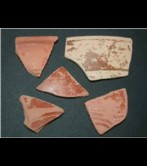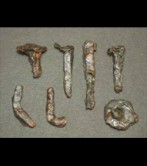San Sebastián, possible Roman fondaco
The existence of the maritime coastal trade in Roman times along the Gulf of Bizkaia is confirmed both by archaeological evidence and written sources. Indeed, records exist of a route that went between Burdigala (Bordeaux), Oiasso (Irun) and Flaviobriga (Castro Urdiales). However, in order to trade along the coast by ship (spending the night on land), stop-off points were necessary. On the Guipuzcoa coast, there are a number of possible anchorages: the bay of Pasaia and the river Oiartzun, San Sebastián, Orio, Getaria and Zumaia, all of which were natural harbours.
The physical configuration of the area of San Sebastián (the bay and the river) together with the requirements of Roman shipping meant that this spot became a point of interest, and thus a settlement was founded to meet the needs of the coastal shipping trade: it was a natural bay that was defended by the island of Santa Clara, Mt Urgull created a well-defined anchorage and, as a result, it could be used as a harbour. In turn, the fleets of the Añorga and the Urumea meant that the rivers became a source of profit, not only in terms of the supply of food (many different fish species), but also because of their navigability, which made it possible to access inland areas of economic interest, a fact that was confirmed in the Middle Ages.
This hypothesis has been strengthened by various finds at the foot of Mt Urgull, even though some of these are out of context (outside the archaeological strata that correspond to this age). Archaeologists have found ceramics from La Rioja from the late 1st century or the early 2nd century AD, as well as coins from the 4th century AD. In other areas of the old part of the city, excavations have unearthed ceramic remains that range from the 1st to the 4th century. One of the most noteworthy sites in the discovery of different Roman pieces is the convent of Santa Teresa, where archaeologists have found different building materials, various types of ceramics, glass and other pieces from the late Imperial age (1st and 2nd centuries AD). Likewise, at the beach and bay of La Concha, other materials from Roman times have come to light: fragments of a wine amphora from the 2nd century AD, remains of triangular stone anchors, fragments of local common ceramics and a coin from the late Imperial age.
In short, it seems reasonable to suppose that for several centuries before the Modern age and during antiquity there were settlements around San Sebastián: one prior to the arrival of the Romans, located further inland, and a second one, in Roman times, at the foot of Mt Urgull, both of which seem to back up the hypothesis regarding coastal shipping and the geostrategic peculiarities of the bay.




